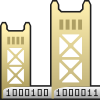 |
Getting Started |  |
| Terminals & Regular Expressions |
| Main | |
|
|
Latest News |
|
|
Getting Started |
|
|
Screen Shots |
|
|
Download |
|
|
Documentation |
|
|
Contributors |
|
|
Contact |
| About GOLD | |
|
|
How It Works |
|
|
FAQ |
|
|
Why Use GOLD? |
|
|
Comparison |
|
|
Revision History |
|
|
Freeware License |
|
|
More ... |
![]()
What is a Terminal?
When talking about grammars, a terminal is any symbol, identifier, reserved word, etc... that describes a piece of data found in the language. Essentially, anything that can be recognized as a meaningful piece of lexical information is a terminal.
What is considered a terminal varies greatly between programming languages. In
most cases, there is significant overlap. For instance, the following piece of text would
specify a simple mathematical expression in most languages:
| 1 + 2 * 3 |
In this example, the terminals are '1', '+', '2','*', and '3'. Often, the format of terminal is specified using a regular expression. This is true of GOLD and many other parsing systems.
Regular Expressions
Introduction
| A regular expression is a simple, yet powerful, notation that is used to represent
simple patterns. They are used extensively in programming language theory. In particular,
regular expressions are used to describe the "terminals" of a programming
language. The notation is fairly easy to master. Each expression consists of a series of characters and sub-expressions delimited using parenthesis '(' and ')'. Any of these items, can be followed by a special character that specifies the number that they can appear in a sequence. The vertical-bar character '|' is used to denote alternate expressions. |
|
|||||||||
|
The asterisk * denotes zero or more of
the selected characters. For instance, the example to the left defines a regular
expression that accepts a letter 'a' followed by zero or more letter 'b's. The text
"a", "ab", "abb", "abbb", etc... would be
accepted. |
||
|
The plus symbol + denotes one or more of
the selected characters. Unlike the last example, because the plus requires one or more
'b's, a single "a" will not be accepted. In other words, the text
"ab", "abb", "abbb", etc... would be accepted. |
||
|
Finally, the question mark ? is used to indicate the selected characters are optional. In other words, they can appear zero or 1 times. In this example, only the text "a" and "ab" would be accepted. |
Notation Variations
Many parsing systems have expanded the notation to include set literals and sometimes named sets. In the case of Lex, literal sets of characters are delimited using the square brackets '[' and ']' and named sets are delimited by the braces '{' and '}'. For instance, the text "[abcde]" denotes a set of characters consisting of the first five letters of the alphabet while the text "{abc}" refers to a set named "abc". This type of notation permits a short-cut notation for regular expressions. The expression (a|b|c)+ can be defined as [abc]+.
It should be noted that standard set notation uses curly brackets to denote a set, not the name of a set. As a result, the notation used by most parsing systems differs quite a bit from the official notation.
Examples
| Defintion | Possible Terminals |
| Example1 = abc* | ab, abc, abcc, abccc, abcccc, ... |
| Example2 = ab?c | abc, ac |
| Example3 = a|b|c | a, b, c |
| Example4 = a[12]*b | ab, a1b, a2b, a12b, a21b, a22b, a111b, ... |
| Example5 = '*'+ | *, **, ***, ****, ... |
| Example6 = {Letter}+ | cat, dog, Sacramento, ... |
| ListFunction = c[ad]+r | car, cdr, caar, cadr, cdar, cddr, caaar, ... |
| ListFunction = c(a|d)+r | The same as the above using a different, yet equivalent, regular expression. |